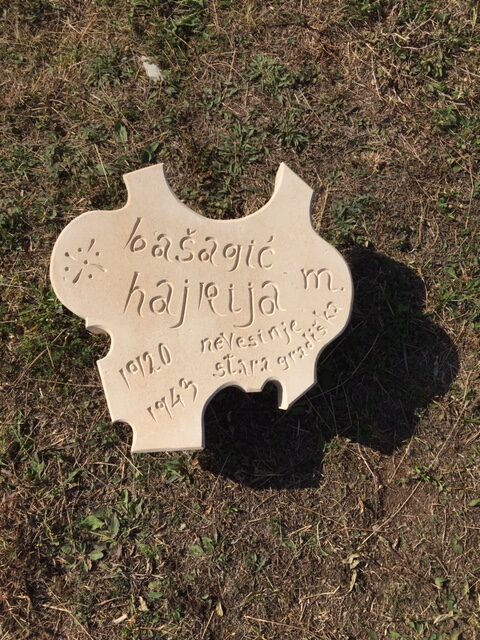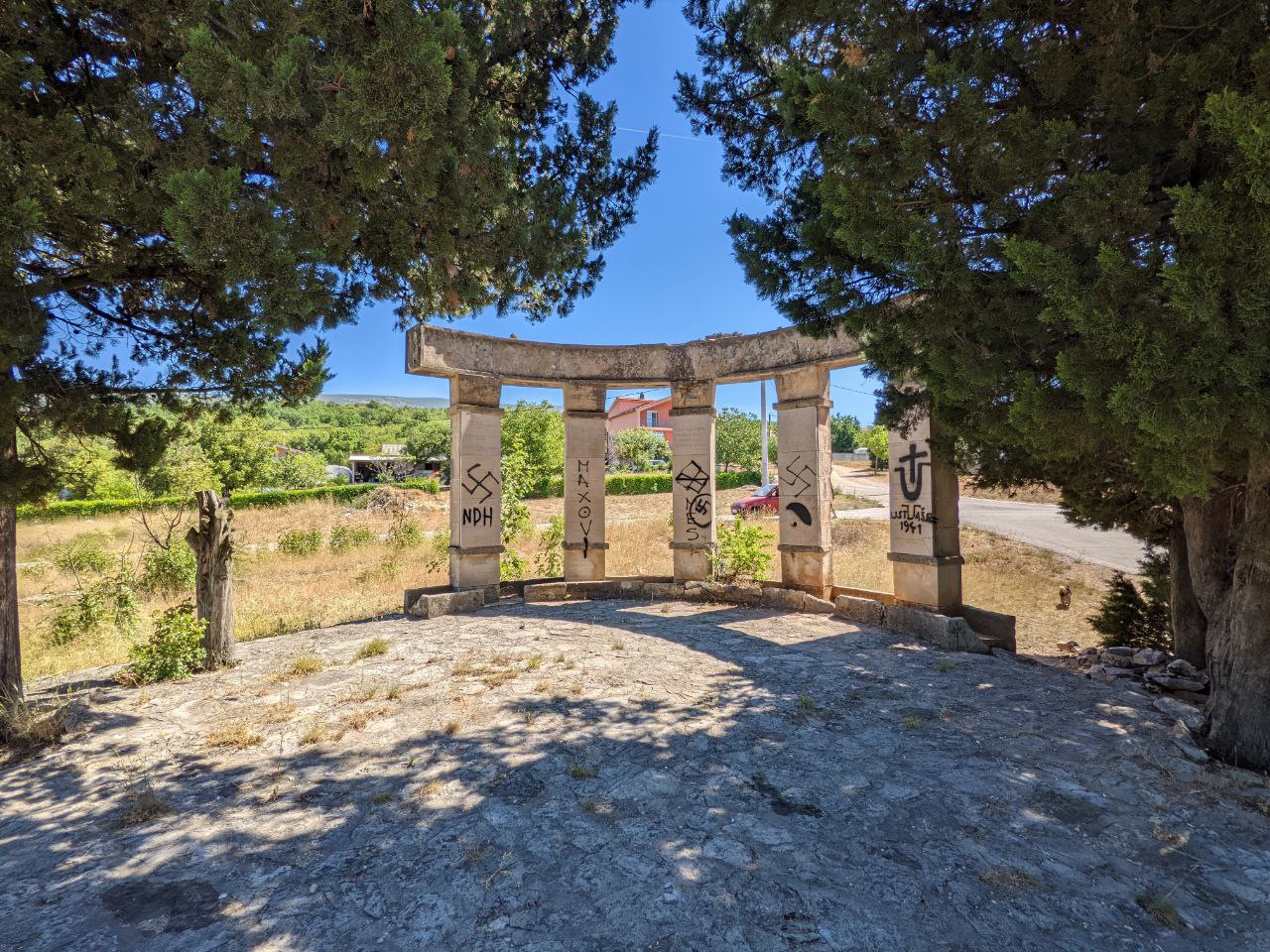
brochure "Partizanski spomenik u Mostaru" (1980)
book “Spomenica Mostara 1941-1945.”
another document or proof of the memorial stone (e.g., a photograph).
Hajrija M. BAŠAGIĆ
HAJRIJA HAJRA BAŠAGIĆ, daughter of MEHMED, born in Nevesinje in 1920, a student of the Faculty of Philosophy, a member of the League of Communist Youth (SKOJ), and a member of the Communist Party of Yugoslavia (KPJ). She lived with her family in Mostar. She conducted courses for nurses, “often working in her apartment, usually with ten of them,” thus preparing future nurses for the detachments. She wrote articles for a women’s bulletin that was prepared in the apartment of Professor Dr. Alojz Benac. From 1941 until the end of 1943, “until the family was dispersed,” the Bašagić house provided refuge for many illegal members. Olga Marasović lived with them for a while, and it was there, in the second half of 1942, that a meeting with the police took place when Svetozar Vukmanović Tempo, a member of the Supreme Headquarters of the People’s Liberation War (NOV i POJ), was in Mostar. For a time, the illegal member Sidika Dika Hadžić also hid at the Bašagićs’ when her discovery was imminent. Hajrija Bašagić was arrested by the Germans on August 20, 1943, together with her sister, who was later released and left extensive memoirs about it.
Hajrija is the sister of fallen fighters Muhidin Bašagić and Mehmed Bašagić.
Several sources state that Hajrija was executed on Ovojci along with her brother Muhidin. However, Hajrija is listed as a victim on the Jasenovac concentration camp database (this information has also been confirmed by the Jasenovac Memorial Site curator), indicating that she was killed in the Stara Gradiška camp in the same year, 1943.
A monument was erected in Ovojci to commemorate those who were executed, and Hajrija’s name is engraved on it.
Excerpts from literature:
The arrival of the police at the Bašagić family’s house was described by Mahmut Konjhodžić in the book “Mostarke”:
“But then trouble ensued. Tempo came to Olga’s for lunch, to the apartment of Hajrija and Safija-Fija Bašagić (…) After checking their identification cards, Tempo began reading the Ustaše newspaper ‘Hrvatski narod’ (Croatian People). In the room were him, Olga, Hajrija, and Fija. At one point, Hajrija looked out the window and uttered just one word: ‘Police’… Tempo remained calm. He simply said to Olga, ‘Hide the identification cards…’ Olga took the identification cards, ran to the pantry, and stuffed them into the beans. Then she approached the door, which the police were already pounding on, and opened it. The first policeman immediately asked, ‘What’s your name?’ ‘Sanija Lipnišević, from Derventa, I’m their cousin…’ ‘Are you not Ćamila?’ the policeman continued to question. Tempo was in the ‘receiving’ room, wearing a hat, and continued reading the newspaper. The policemen had not yet seen him. Then he moved to the table set for lunch. The day before, there had indeed been a girl named Ćamila from Gabela near Čapljina at Hajrija’s, talking about how the police were after her. Like an ordinary Muslim girl, Olga talked to the policemen about this Ćamila without mentioning that she was there. And at one point, the policeman said, ‘Well, you also seem suspicious to me. Did you register in Mostar?’ ‘I did not register, we do not register at all in Derventa.’ ‘Come with us!’ the agent said. ‘But I have a permit,’ Olga replied, rushing to bring a valid permit from Derventa in the name of Sanija Lipnišević. The other agent carefully examined the permit, and said to the one who had suspected Olga, ‘Leave the woman alone, let’s see how big your apartment is…’ He crossed the hallway and entered the room where Tempo was. Tempo was still reading the Ustaše newspaper ‘Hrvatski narod’ while having lunch and pretended not to see the agent, who returned from the room without any comment… The police were looking for Ćamila, so they didn’t pay much attention to Tempo…”
Safija-Fija about the arrest:
“I remember it well, it was a beautiful August morning, around four o’clock, when we were suddenly awakened by a pounding on the door. It was dawn on August 20, 1943. I peeked out the window and noticed many uniformed Germans in the yard, and one in civilian clothing. Several of them were lying on the ground, but they had their machine guns pointed towards the door of the house. At the same time, Hajrija got up, and I went downstairs to open the door. As soon as I opened it, they surrounded me and began questioning me incessantly, repeating these questions: Is Okrugla here? Where is Traktor? They must be here! They are definitely here… While some surrounded me, others quickly went upstairs holding pistols and rifles at the ready. Later, they ordered my sister and me to get dressed, but they didn’t allow us to be near each other, they separated us. In the meantime, they ransacked everything, conducting a thorough search. They took all the photographs, letters, books, regardless of their political content, as well as professional books and the like. Additionally, they took all the documents. They asked my sister Hajra about her occupation. She replied that she was a homemaker, but when they found her student ID during the search and read that she was a student in Belgrade, they sneered and criticized, ‘Another Belgrade student…’ They slapped her a few times. The civilian who led the German soldiers was addressed by them as ‘Herr Ekhart.’ Everything they separated – books, documents, pictures, and other items – they packed into suitcases. They also found a few leaflets – bulletins that we hadn’t managed to distribute, and some of Hajrija’s notes, probably for a women’s bulletin. They drove us to Vladičin House prison in a car. Upon arrival at the building, the civilian ordered the guards to take me to room number three, and they immediately took Hajrija upstairs, probably for interrogation. In the cell, I didn’t find anyone. It was damp and dark, without windows. I had difficulty breathing. I know that when I arrived, they transferred someone from there to the adjacent room. After some time, maybe around two hours later, I heard Hajrija returning accompanied by guards. They also locked her up in the adjacent cell, and shortly after, I heard them splashing water in the cell, and presumably on her as well. At the same time, I could hear my sister’s sighs. Two days later, when they took away the chamber pot, I managed to catch a glimpse of my sister through the peephole. She was huddled in one corner. She looked bewildered. We locked eyes, and I never saw her again after that.”
Halilbegović, Nihad (2006): Bošnjaci u jasenovačkom logoru ; https://www.portalnovosti.com/mostarke-otpor-u-zicama; Ćemalović, Enver (1986): Mostarski bataljon, Mostar ; Miletić, Antun: “Koncentracioni logor Jasenovac 1941-1945. Dokumenta“, knj. I-II, 1986, knj. III, 1987, knj. IV, 2007, str. 2500, Narodna knjiga, Gambit, Belgrade, Jagodina; Konjhodžić, Mahmud (1981): “Mostarke”: fragmenti o revolucionarnoj djelatnosti i patriotskoj opredjeljenosti žena Mostara, o njihovoj borbi za slobodu i socijalizam, Opštinski odbor SUBNOR-a Mostar; grupa autora: Spomenica Mostara 1941-1945; https://www.facebook.com/photo/?fbid=373566901636725&set=a.110622951264456
Photo of the memorial plaque: S. Demirović, spomenicinob.info
Do you have more information about this fighter? Share your stories and photographs. Let's keep the memory alive!




